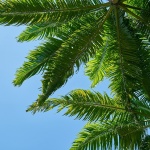Palm trees have been a source of nourishment for different people across different nations and cultures across time. There are 2,500 species of palm trees and many of these species bear something that is edible and helped mankind survive throughout his existence. And the interesting thing is, almost all of the palm tree species can be found in Florida. So, we have gathered our own top ten palm trees that have edible fruits. And since most of the land area of the sunshine state is covered with palm, chances are all of these fruit-bearing palm trees can be found in Florida.
Coconut palm – while technically not a fruit, the coconut is generally eaten the all over the world. The oil is a typical cooking oil, and the water inside the youthful coconut is additionally a broadly popular refreshment.
Date palm – dates are a staple sustenance in the Middle East and have been developed since old days (beginning is likely in/around Mesopotamia and Egypt). Date cultivars are described as delicate, semi-delicate and dry or bread dates. Chewy bread dates keep longer and can be utilized for “survival nourishment” on long treks.
Oil palm – this palm is generally utilized for business palm oil creation, and the oil contains more fats than other vegetable based oils, but contains zero trans-fats. It is generally used as a part of daily consumption for many people.
Peach palm – local to Central and South America, the peach palm develops nutritious organic products that have been utilized as sustenance for a considerable length of time in history. The natural products must be cooked for 3-5 hours with a specific end goal of being devoured (just kidding, always mind your table manners). These palms are additionally cultivated for their hearts of palm and are likewise used to feed livestock.
Betel Nut palm – otherwise called the areca nut, a couple of cuts of the betel nut is normally wrapped – alongside flavors – into betel leaves and bitten for its mellow stimulant impacts, like how tobacco is but bitten. Biting betel nut is a typical and critical custom in Asian and Oceanic nations.
Açaí palm – the açaí palm is developed for both its natural product (known as açaí berry), and for hearts of palm.
Jam palm – the jam palm organic products are consumable, and are regularly used to make mixed drinks in South America, where the tree is local
Snake palm – otherwise called “salak”, this palm species is local to Java and Sumatra. The organic product is referred to as “wind natural product” because of the ruddy dark colored textured skin. At the point when peeled back, the mash of the natural product is edible and is sweet and acidic.
Chilean wine palm – the common name of this palm alludes to the past utilization of the sap from the an important part of this palm to create wine. The sap is additionally boiled down into a syrup and sold locally in South America and the Canary Islands as miel de palma.
Saw Palmetto palm – proclaimed for its restorative uses, saw palmetto natural products are loaded with unsaturated fats and phytosterols, and the concentrate has been deemed as valuable for individuals with prostate problems.










